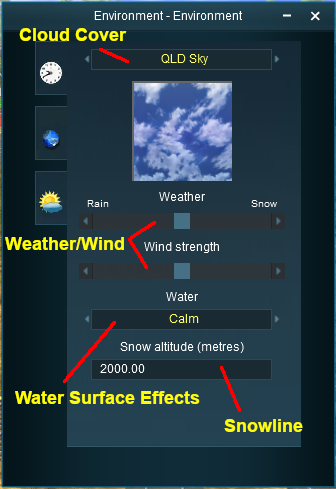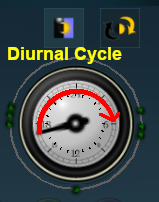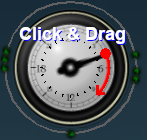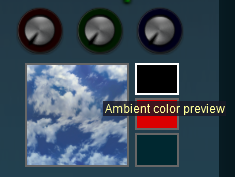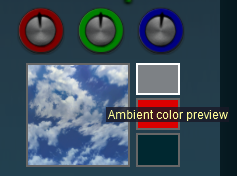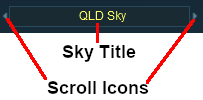|
|
| Line 980: |
Line 980: |
| | | | |
| | The top section is a standard calendar selection tool that allows you to set the month and the day of the month. The only effect this has in '''Trainz''' is to set, with the geographic coordinates, the season of the year. | | The top section is a standard calendar selection tool that allows you to set the month and the day of the month. The only effect this has in '''Trainz''' is to set, with the geographic coordinates, the season of the year. |
| | + | <br> |
| | + | <table bgcolor=#eeeeee> |
| | + | <tr> |
| | + | <td colspan="2"> |
| | + | ----</td> |
| | + | </tr> |
| | + | <tr valign="top"> |
| | + | <td>[[image:Gears.PNG|link=]]</td> |
| | + | <td><span style="font-size: 17px; font-weight: 700;">Settings:'''</span><br> |
| | + | '''Set the Month''' by scrolling '''left''' or '''right''' through the 12 month calendar<br> |
| | + | '''Set the Day''' by clicking on the date in the selected month |
| | + | </td> |
| | + | </tr> |
| | + | <tr valign="top"> |
| | + | <td colspan="2"> |
| | + | ----</td> |
| | + | </tr> |
| | + | </table> |
| | + | |
| | + | <table bgcolor=#000000> |
| | + | <tr valign="top"> |
| | + | <td> |
| | + | <table bgcolor=#ffffb0> |
| | + | <tr valign="top"> |
| | + | <td>[[image:NotePad.PNG|link=]]</td> |
| | + | <td>It is possible to set a particular '''Year''' by scrolling through all the 12 month calendars to reach the required year '''BUT''' this will have no effect on the operation of the '''Route''' or '''Session'''. Setting the year to '''1900''', for example, will not recreate an early 20th Century railroad. Different time periods have to be recreated by carefully selecting scenery and rolling stock assets that belong to that time period. |
| | + | </td> |
| | + | </tr> |
| | + | </table> |
| | + | </td> |
| | + | </tr> |
| | + | </table> |
| | <br> | | <br> |
| | <table cellpadding=4 bgcolor=#c1e7e7> | | <table cellpadding=4 bgcolor=#c1e7e7> |
| Line 991: |
Line 1,023: |
| | </tr> | | </tr> |
| | </table> | | </table> |
| − | | + | <br> |
| | If you:- | | If you:- |
| | *Load a '''Session''' into Surveyor. Change the date then select and edit a '''Session Layer''' (add, remove or move an object). Save. The new date will be stored in the '''Session'''. | | *Load a '''Session''' into Surveyor. Change the date then select and edit a '''Session Layer''' (add, remove or move an object). Save. The new date will be stored in the '''Session'''. |
Revision as of 17:42, 10 April 2022
The information in this Wiki Page applies to TANE, TRS19, Trainz Plus and TRS22. A video tutorial specific to setting the environmental controls in TRS19, Trainz Plus and TRS22 can be found at TRS19 Environment and Lighting Tutorial
| In Summary: |
 |
The Environment Tools are used to set:-
- the skybox - to configure the cloud cover
- the weather - from rain to snow to clear. Weather can also be set from the Main Menu - Settings options and by using Session rules
- the wind speed - which will affect the swaying motion of Speedtrees
- the snowline - the minimum snow altitude for assets that have a snow effect layer. Used with world origin altitude setting
- the date - for assets that have different seasonal options. Used with world origin to set the season of the year
- the lighting - the light levels and colours through a 24 hour period
- the water colour and water surface effects (smooth, rough, etc)
- the road traffic - enabled/disabled
- the world origin - geographic coordinates (used with date to set the season of the year) and altitude (used with snowline to set snow effects)
|
 |
The Time of Day is set using Session rules such as  Startup Option Rule and Startup Option Rule and  Time and Rate Rule Time and Rate Rule |
 |
Notes:
- There is no Save or OK button on the Environment Tools Window. As soon as you enter or select a setting it will be set. When finished editing simply click the window Off button BUT make sure you SAVE before exiting Trainz.
- Seasons (for those assets that show seasons - e.g. snow, leaf colours, etc) are controlled by the
 Date, Date,  Snow Altitude (for snow effects) and Snow Altitude (for snow effects) and  Location (World Origin) settings. January = summer in the Southern Hemisphere and winter in the Northern Hemisphere Location (World Origin) settings. January = summer in the Southern Hemisphere and winter in the Northern Hemisphere
|
|
Loading and Saving Environmental Settings
 |
A newly created Route will have its environmental settings set to their default values |
 |
A newly created Session will have its environmental settings set to those of the Route |
 |
Where both the Route and Session have saved environmental settings, then those in the Session will be used |
In Routes
- When you create a new Route, or load an existing Route with NO saved Environmental settings, then the settings used will be the default values.
- If you change any of the Environmental settings of a Route then you must also edit the Route (e.g. change or edit a Route asset or feature) and save it for those settings to become part of the Route.
In Sessions
- When you create a new Session, or load an existing Session with NO saved Environmental settings, then the Session will use the settings that are part of the Route. These could also be the default settings.
- When you load an existing Session with saved Environmental settings, then the settings from the Session will take priority over any settings that have been saved in the Route.
- If you change any of the Environmental settings of a Session then you must also edit the Session (e.g. change or edit a Session asset or property) and save it for those settings to become part of the Session.
 |
Because a Session can have its own environmental settings you are able to create Sessions set in different conditions - for example:-
- separate summer and winter sessions or for any season - see the
 Set Date and Set Date and  Set World Origin sections below Set World Origin sections below
- an early morning winter fog Session - see the
 Fog Control section below Fog Control section below
- a spring rain shower Session - see the
 Set the Weather section below Set the Weather section below
- a cool overcast autumn (fall) Session - see the
 Set the Sky section below Set the Sky section below
|
|
The Environment Tool
Open the Environment Tools Editor from the Surveyor Main Menu in TANE as shown below left or from the Surveyor Edit Menu in TRS19 and later versions as shown below right.
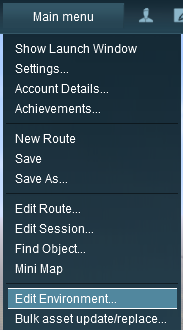 |
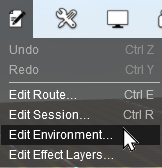 |
In all versions select Edit Environment |
This will open the Environment Properties Window as shown below.
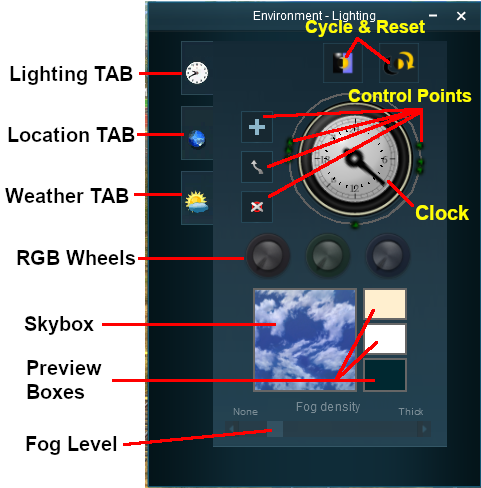
|
TRS19 and later Trainz versions have an additional control that adjusts the lighting level, as shown below
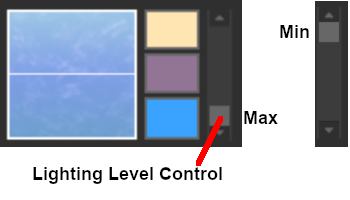
|
Lighting
 |
The Lighting Tools control the ambient, sun and water colours. This tool tab is opened by default whenever the Environment Editor is opened |
Light and Time
 |
The dial shown is a 24 hour clock that sets the lighting conditions at selected times of the day and night |
Setting the Lighting Conditions
Colour Control Points
The ring around the dial contains a number of green dots.
 |
Each dot is a Control Point that sets the specific Red, Green and Blue colour values, and other lighting features, at the time shown on the clock |
 |
Each colour value can be altered by dragging its needle point to a new position around the dial. Each new position will change the balance between the 3 colours and will alter the lighting displayed in the scene at that particular time. |
Types of Lighting
 |
Notes:
Each control point stores the RGB values for three different types of lighting in the scene.
- The Ambient Colour which is the directional lighting and mostly affects the hue of buildings and other scenery objects
- The Sun Colour which affects the colour of the sunlight and mostly affects the hue of the terrain
- The Water Colour which affects the colours reflected by water surfaces
|
|
The 3 boxes below the colour wheels and next to the Sky box show the colour effects created for each type of lighting at the selected time.
Ambient Colour
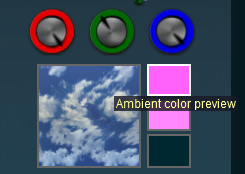 |
|
 |
Steps:
- Click on the top box of the three. This is the Ambient Colour
- The dials will show the RGB values for the Ambient Colour at the selected time
- The Ambient color preview box will show the colour produced by the RGB settings
- You can then change the RGB settings for the Ambient Colour
|
|
|
Sun Colour
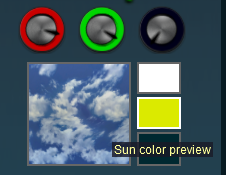 |
|
 |
Steps:
- Click on the middle box of the three. This is the Sun Colour
- The dials will show the RGB values for the Sun Colour at the selected time
- The Sun color preview box will show the colour produced by the RGB settings
- You can then change the RGB settings for the Sun Colour
|
|
|
Water Colour
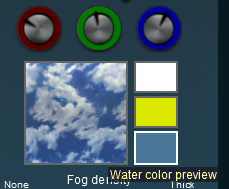 |
 |
Water Colour values set for one control point become the values for ALL the control points
|
|
|
 |
Steps:
- Click on the bottom box of the three. This is the Water Colour
- The dials will show the RGB values for the Water Colour
- The Water color preview box will show the colour produced by the RGB settings
- You can then change the RGB settings for the Water Colour
|
|
|
Mixing Colours
 |
Notes:
Getting the "right colours" can be more of an art than a science. To set the exact colour you want means mixing the correct quantities of Red, Green and Blue. Each of these colours has 256 different values from 0 to 255 that, when combined, produce over 16 million different possible colours - but many monitors and most eyeballs will not be able to tell the differences between many of those 16 million colours.
|
|
 |
Setting all three colours to the same values will produce monotones from Black to White with 254 different shades of gray between those two tones.
 |
You can quickly set all three dials to the exact same value by holding down the Shift key as you click on a dial position on any one of the three dials. |
Note that in the examples below, the "tyre" around each dial shows the exact quantity of colour that is being added. |
|
Example 2: Setting a Water Colour
|
| Creating a colour suitable for water (RGB values are approximate) |
|
TRS19/Trainz Plus/TRS22 Lighting Level Control
In TRS19 and later Trainz versions users have an additional control that is placed next to the Ambient, Sun and Water colour boxes. This sets the overall brightness or lighting level for each control point.
|

|
|
 |
Steps:
Select a control point, then:-
- Move the slider to the BOTTOM to give maximum brightness level
- Move the slider to the TOP to give minimum brightness level
- Move the slider to a point in between these two positions for an intermediate lighting level
Repeat for each control point as required.
|
|
|
Resetting the Lighting Conditions
 |
All the lighting colour settings can be reset back to the Trainz default colours. |
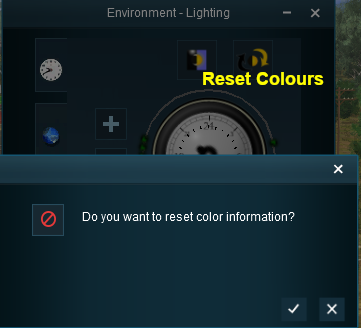 |
|
 |
Steps:
- Click the Color Reset button, then either:-
- Click the
 icon to accept the reset, or icon to accept the reset, or
- Click the
 icon to reject the reset icon to reject the reset
|
|
|
Adding a New Control Point
 |
New control points can be added to the clock dial |
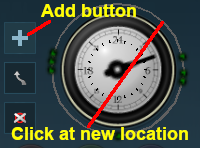 |
|
 |
Steps:
- Click the Add button

- Click on the ring at the place where the new control point is to be located
|
 |
Notes:
The Add button will remain active (selected) until it is deactivated so clicking on the ring again will add another control point.
The button can be deactivated by clicking on it again or by selecting another button.
|
|
|
|
|
|
Deleting a Control point
 |
Existing control points can be deleted |
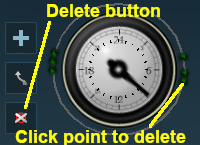 |
|
 |
Steps:
- Click the Delete button

- Click on the control point to be deleted
|
 |
Notes:
The Delete button will remain active (selected) until it is deactivated so clicking on another control point will also delete that point.
The button can be deactivated by clicking on it or by selecting another button.
|
|
|
|
|
|
Moving a Control point
 |
Existing control points can be moved |
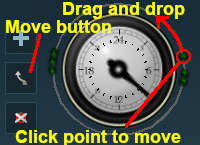 |
|
 |
Steps:
- Click the Move button

- Click on the control point to be moved and either:-
- hold the mouse button down and drag the point to its new position around the ring, or
- click on the ring at the spot where the point is to be placed
|
 |
Notes:
The Move button will remain active (selected) until it is deactivated so clicking again on the ring will move the selected control point again.
The button can be deactivated by clicking on it again or by selecting another button.
|
|
|
|
|
|
The Skybox
 |
The Skybox sets the sky colours in three different regions of the sky at the selected time of day, as shown in the extreme example below |
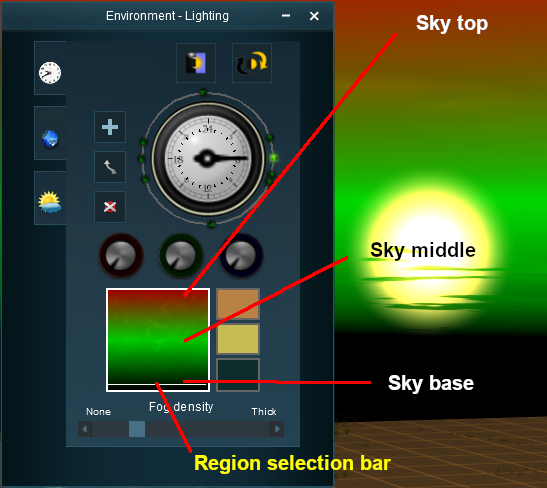 |
 |
Note:
Each control point also stores the Skybox settings for that particular time
|
|
|
 |
Steps:
- Select a control point for a specific time of day
- Click in a region of the Skybox (top, middle, bottom) - a while line or bar will appear across the selected region
- Set the RGB color wheels for the selected region
- Repeat for the other two regions and for other times of the day/night as needed
|
|
In the areas between the three regions the colours will be blended to create a smooth transition.
 |
Do you need an Overcast Sky for your scene?
- For each daylight control point set each Skybox region (top, middle, bottom) to shades of gray (see Mixing Colours above).
- In the Environment Tab (see below), set the Sky Type to No Cloud 01
Note: This will not remove or hide the sun.
|
|
|
Fog Control
 |
This controls the level of "fog" in the scene |
Location
 |
The Location Tools control the geographic and date (season) data for the Route and Session |
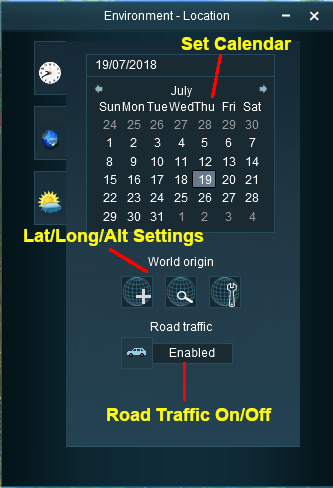 |
Set Date
The top section is a standard calendar selection tool that allows you to set the month and the day of the month. The only effect this has in Trainz is to set, with the geographic coordinates, the season of the year.
|
 |
Settings:
Set the Month by scrolling left or right through the 12 month calendar
Set the Day by clicking on the date in the selected month
|
|
 |
It is possible to set a particular Year by scrolling through all the 12 month calendars to reach the required year BUT this will have no effect on the operation of the Route or Session. Setting the year to 1900, for example, will not recreate an early 20th Century railroad. Different time periods have to be recreated by carefully selecting scenery and rolling stock assets that belong to that time period.
|
|
 |
The entered date can be saved in the Route, the Session or both depending on whether you are editing the Route or the Session |
 |
You must make a change to an object in a Route Layer or a Session Layer for the date change to be recorded as part of the Route or the Session (or both) |
If you:-
- Load a Session into Surveyor. Change the date then select and edit a Session Layer (add, remove or move an object). Save. The new date will be stored in the Session.
- Load a Route into Surveyor. Change the date then select and edit a Route Layer (add, remove or move an object). Save. The new date will be stored in the Route.
- Load a Session into Surveyor. Change the date then select and edit a Route Layer (add, remove or move an object). Then select and edit a Session Layer (add, remove or move an object). Save. The new date will be stored in both the Route and the Session.
 |
Sick of Winter in Your Session During Winter? Want it to Always Be Summer or Spring?
Set the date to a Summer or a Spring month (or a Winter month if that is your "thing"). This will be saved when you save the Session.
|
|
 |
There is an order of priority with dates in Routes and Sessions |
- If the Route and the Session are saved with different dates, then the Session date will decide the visible season.
- If a Session does not have a saved date, then the date saved in the Route will decide the visible season.
- If no date has been saved in the Route and the Session, then today's date will decide the visible season.
|
Set World Origin
The middle section is the World Origin Tool and sets the geographic location, including the altitude, of the route using a World Origin marker that is only visible in Surveyor.
 |
Setting the World Origin does NOT set regional features such as which side of the road the cars drive on. Use the Route Editor - Region setting for that |
 |
The World Origin is always part of a Route, not part of a Session |
Once it has been placed, the marker can be moved by dragging or clicking with the mouse. After adding the marker it should be edited to add geographic data.
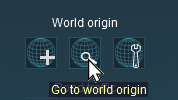 |
Click the Go to world origin icon to move the Surveyor screen so that it is centred on the World Origin marker. |
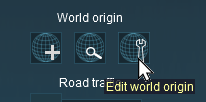 |
Click the Edit world origin icon to set or edit the World Origin data. See Editing the World Origin below. |
Editing the World Origin
Deleting the World Origin
 |
There is no delete button for the World Origin marker, but you can still delete it |
|
 |
Steps:
- Open the Objects Tool in the Surveyor screen
- Select the Delete tool
- Click on the World Origin marker
|
|
|
 |
Notes:
All routes MUST have a World Origin.
If you delete the marker then the World Origin will be hidden and will take the default coordinates of latitude 52.45 N, longitude 13.3 E, altitude 0 metres - which places it in Berlin(??).
|
|
|
Traffic Control
 |
This tool simply turns the road traffic ON and OFF |
 |
Notes:
This road traffic tool:-
- only works on roads that have been designed to use road traffic (not all roads support traffic)
- does not set the road traffic characteristics - the number and types of vehicles, which side of the road is used. These features are set in the Route Editor - Region by assigning a Region to the route. Details on how to create and assign a Region asset can be found in the
 Create a Region Asset Wiki page Create a Region Asset Wiki page
|
|

 |
|
 |
Settings:
- Click the car icon to enable and disable traffic
|
|
|
Weather and Water
To set the water colour, refer to the  Setting the Lighting Conditions section above.
Setting the Lighting Conditions section above.
Wind Strength
 |
This setting only effects SpeedTrees |
|
 |
Settings:

Move the slider to set the wind strength between zero (left) and maximum (right)
|
|
Set the Water Surface
 |
This sets the water surface effects |
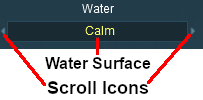 |
|
 |
Settings:
- Click the Water Surface to select from a drop down list of surface effects, or
- Scroll through the list by using the Scroll icons
|
|
|
Set the Snow Altitude
 |
This sets the altitude at which objects with snow effects will display those effects. It has no effect on objects created without this feature |
Trainz Wiki
 |
More Tutorials and Guides to Using Trainz
|
This page was created by Trainz user pware in July 2018 and was last updated as shown below.



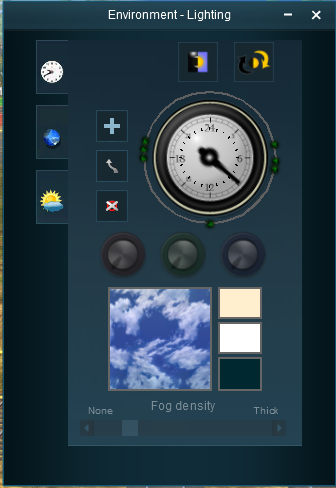
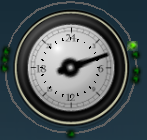










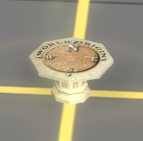


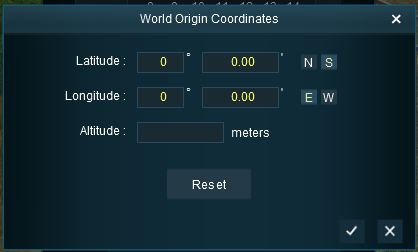

Setting the Lighting Conditions section above.
